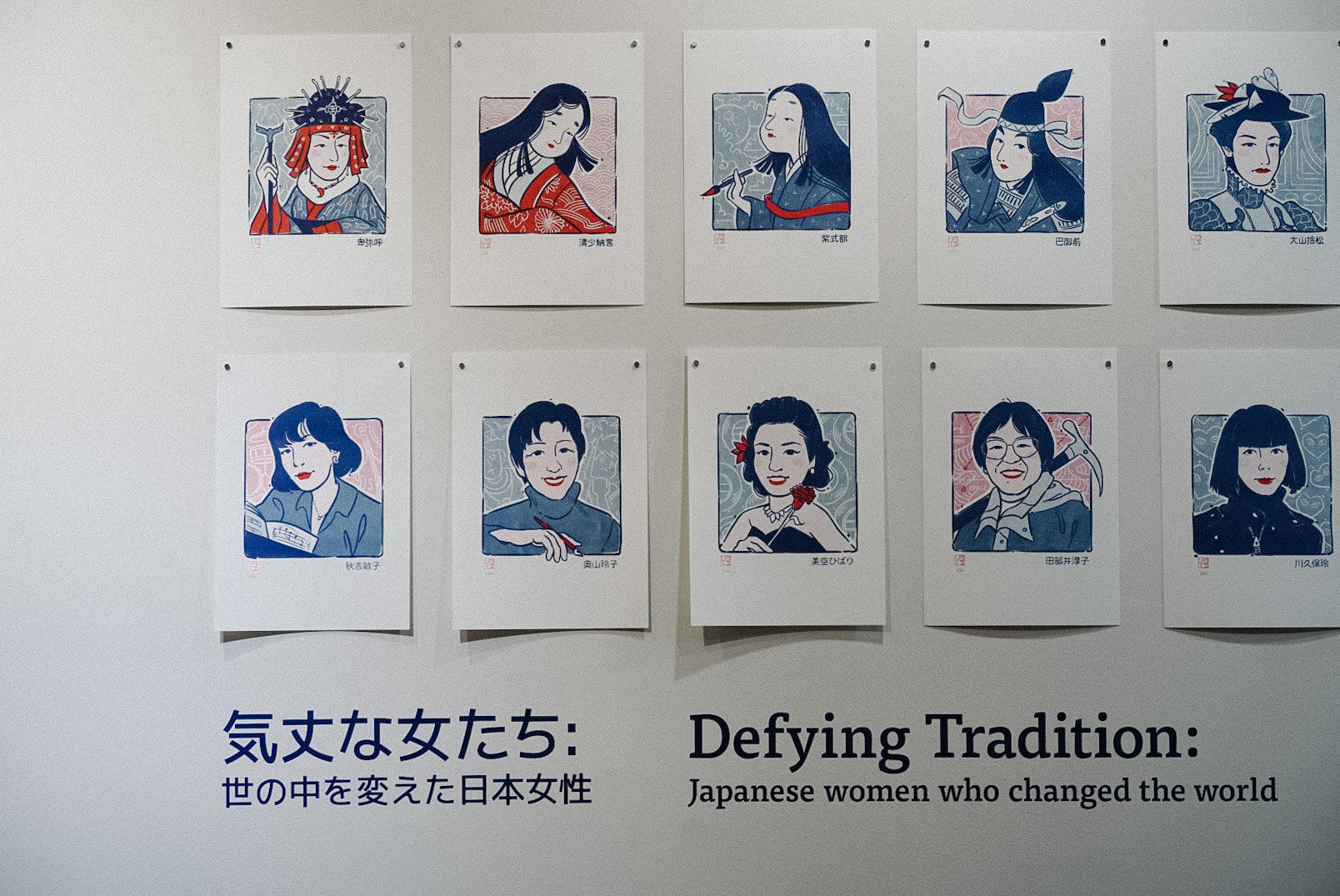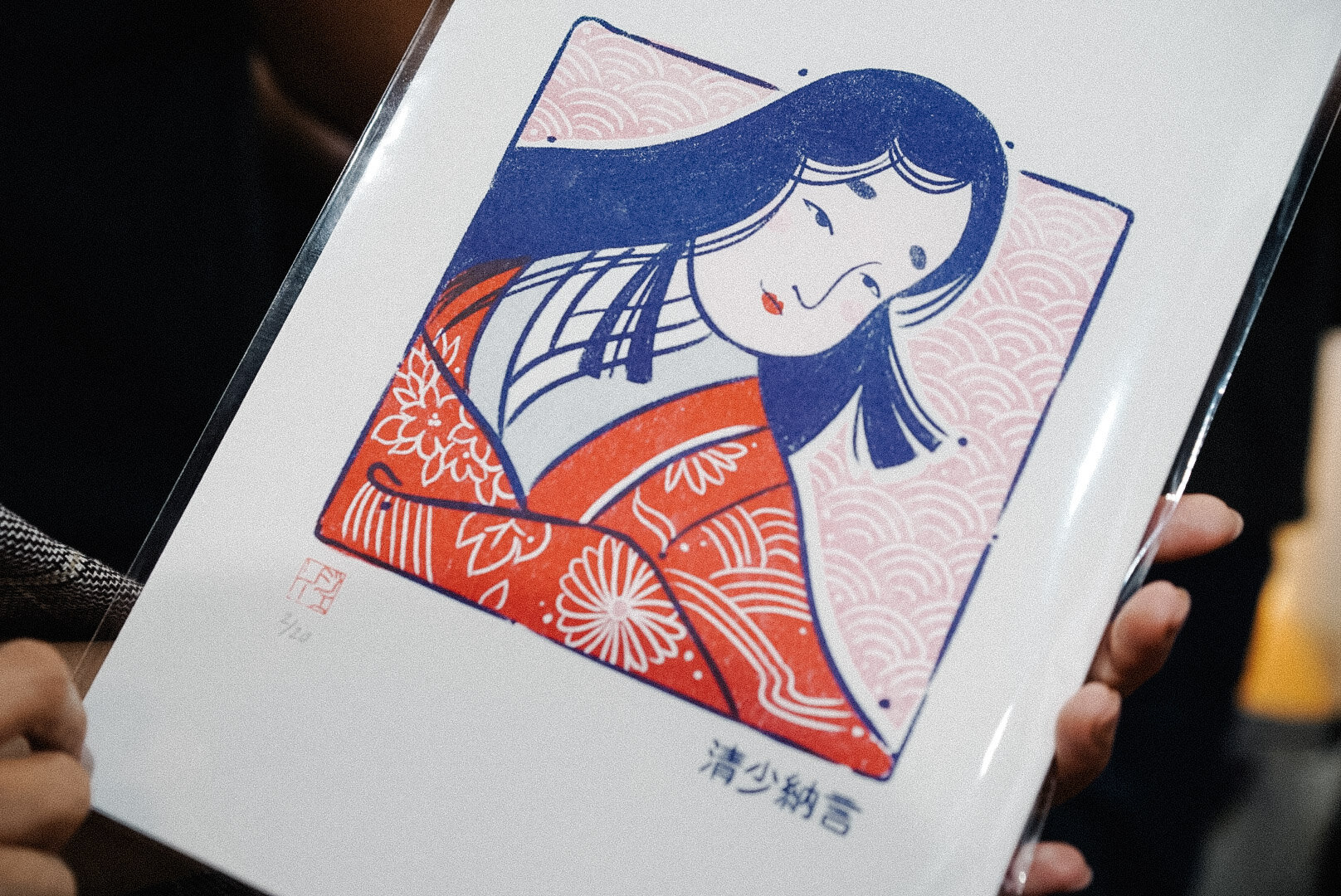 Image 1 of 5
Image 1 of 5

 Image 2 of 5
Image 2 of 5

 Image 3 of 5
Image 3 of 5

 Image 4 of 5
Image 4 of 5

 Image 5 of 5
Image 5 of 5






Murasaki Shikibu 紫式部 - A4 Riso Print (Signed and Numbered)
Murasaki Shikibu 紫式部
Writer of the first novel in the world
世界最古の長篇小説の平安時代の作家 (970年から978年の間に生まれ、1019年)
「父親は、深い学識のある人だが、いつもその事実を後悔した。『残念だ!』とよく言った、『惜しむらくは、この子がどうして男に生まれなかったかなぁ!』」
Novelist Murasaki Shikibu was a lady-in-waiting at the Imperial Court in Heian-period Japan. In Heian-era Japan, the new kana writing system was used by noblewomen and reserved for more intimate language, while men were taught to write in formal Chinese. Women were thought to be incapable of “real intelligence” and as a result, were not educated in Chinese. Murasaki, however, had a natural talent and became proficient in classical Chinese while listening to her brother during his studies. When she surpassed his ability to understand and memorise passages, she recounted in her diary, “Father, a most learned man, was always regretting the fact; ‘Just my luck,' he would say, 'What a pity she was not born a man!'"
When Murasaki married, her servants ran the household and did much of the childcare, allowing her to focus on her reading and writing. Two years after the birth of their daughter, Murasaki’s husband died, and it was around this time that scholars suspected she began writing her famous novel, The Tale of the Genji. The work is a depiction of the lifestyles of high courtiers in the Heian period and recounts the life of Hikaru Genji, the son of an ancient emperor. Due to its extensive character development and plot, it is widely considered to be the world’s first novel.
As The Tale of Genji and works from fellow Heian women writers were written in kana, they became an essential influence on the development of Japanese into a written language. The novel went on to inspire centuries of people and became a popular subject of ukiyo-e artists, including Hiroshige, who illustrated his own versions of the story.
What is a riso print?
These prints use risograph technology, a method of printing developed in Japan in the mid-1980s. It can be described as a mix between screenprinting and photocopying. The risograph process produces prints with extremely vibrant, crisp inks, and sometimes these inks overlap during the printing process to create interesting and unique details. These soy-based inks also have a lower environmental impact.
Product details
Printed in Tokyo, Japan by Hand Saw Press print studio. Each print is A4 size (210 x 297 mm / 8.27 x 11.69 in) and printed on Natural White 186gsm Takeo Araveal paper. Acid-free and FSC Approved.
Each print is signed with a traditional Japanese ‘hanko’ artist stamp and hand-numbered from a limited edition of 20. Prints are packaged in cello bags with rigid cardboard inserts and shipped in flat mailers.
Please note that frames are not included.
Delivery times & prices
We ship worldwide. 日本へ国際郵便で送ります。
UK deliveries: 3-4 working days via Royal Mail 1st class
International deliveries available via Royal Mail International Standard Airmail
Prices calculated during checkout
For more information on shipping times for international deliveries, please check the delivery & returns page.
Murasaki Shikibu 紫式部
Writer of the first novel in the world
世界最古の長篇小説の平安時代の作家 (970年から978年の間に生まれ、1019年)
「父親は、深い学識のある人だが、いつもその事実を後悔した。『残念だ!』とよく言った、『惜しむらくは、この子がどうして男に生まれなかったかなぁ!』」
Novelist Murasaki Shikibu was a lady-in-waiting at the Imperial Court in Heian-period Japan. In Heian-era Japan, the new kana writing system was used by noblewomen and reserved for more intimate language, while men were taught to write in formal Chinese. Women were thought to be incapable of “real intelligence” and as a result, were not educated in Chinese. Murasaki, however, had a natural talent and became proficient in classical Chinese while listening to her brother during his studies. When she surpassed his ability to understand and memorise passages, she recounted in her diary, “Father, a most learned man, was always regretting the fact; ‘Just my luck,' he would say, 'What a pity she was not born a man!'"
When Murasaki married, her servants ran the household and did much of the childcare, allowing her to focus on her reading and writing. Two years after the birth of their daughter, Murasaki’s husband died, and it was around this time that scholars suspected she began writing her famous novel, The Tale of the Genji. The work is a depiction of the lifestyles of high courtiers in the Heian period and recounts the life of Hikaru Genji, the son of an ancient emperor. Due to its extensive character development and plot, it is widely considered to be the world’s first novel.
As The Tale of Genji and works from fellow Heian women writers were written in kana, they became an essential influence on the development of Japanese into a written language. The novel went on to inspire centuries of people and became a popular subject of ukiyo-e artists, including Hiroshige, who illustrated his own versions of the story.
What is a riso print?
These prints use risograph technology, a method of printing developed in Japan in the mid-1980s. It can be described as a mix between screenprinting and photocopying. The risograph process produces prints with extremely vibrant, crisp inks, and sometimes these inks overlap during the printing process to create interesting and unique details. These soy-based inks also have a lower environmental impact.
Product details
Printed in Tokyo, Japan by Hand Saw Press print studio. Each print is A4 size (210 x 297 mm / 8.27 x 11.69 in) and printed on Natural White 186gsm Takeo Araveal paper. Acid-free and FSC Approved.
Each print is signed with a traditional Japanese ‘hanko’ artist stamp and hand-numbered from a limited edition of 20. Prints are packaged in cello bags with rigid cardboard inserts and shipped in flat mailers.
Please note that frames are not included.
Delivery times & prices
We ship worldwide. 日本へ国際郵便で送ります。
UK deliveries: 3-4 working days via Royal Mail 1st class
International deliveries available via Royal Mail International Standard Airmail
Prices calculated during checkout
For more information on shipping times for international deliveries, please check the delivery & returns page.










